 Gardening Gone Wild has started a Plant Pick of the Month where they invite garden bloggers to write about a specific plant. This month's pick is roses. I love roses. The comment I so frequently get is "It's so hard to grow roses." In my neighborhood, due to the misconception that the only roses which are easy to grow are carpet roses, that's all you see. In the garden centers, there too you see mostly carpet roses and the Knock Out roses. These are great roses, but what about the heirloom roses?
Gardening Gone Wild has started a Plant Pick of the Month where they invite garden bloggers to write about a specific plant. This month's pick is roses. I love roses. The comment I so frequently get is "It's so hard to grow roses." In my neighborhood, due to the misconception that the only roses which are easy to grow are carpet roses, that's all you see. In the garden centers, there too you see mostly carpet roses and the Knock Out roses. These are great roses, but what about the heirloom roses?
~
The old garden roses are so easy to grow. In most cases, you can dig a hole, add in some compost, plant the rose, water it well for the first year, and from there its requirements are the same as other shrubs in your garden. What they lack in remontancy is made up with fragrance and profusion of bloom. Also, if you grow the Portlands and Bourbons, you can have repeat blooming shrubs as well.
~
I cannot image my garden without the beauty, fragrance, reliability, and link to the past that old garden roses provide. I love them all, but here are six heirloom roses that are particularly wonderful.
~ 1. Rose de Rescht. Rose de Rescht (pictured) is a Portland rediscovered in the 1940s. It's small stature of three to four feet tall and wide makes de Rescht easy to mix into shrub or mixed borders. This rose is a deep pink with many petals and an amazing fragrance. Rose de Rescht, like others in the Portland class, blooms remontantly throughout the summer and fall. The foliage is plentiful and not prone to disease.
1. Rose de Rescht. Rose de Rescht (pictured) is a Portland rediscovered in the 1940s. It's small stature of three to four feet tall and wide makes de Rescht easy to mix into shrub or mixed borders. This rose is a deep pink with many petals and an amazing fragrance. Rose de Rescht, like others in the Portland class, blooms remontantly throughout the summer and fall. The foliage is plentiful and not prone to disease.
~
2. Paul Neyron. Paul Neyron is a Hybrid Perpetual rose from the mid-1800s. As a class, the Hybrid Perpetuals are not as easy to care for as the other classes of old roses. By the end of the summer, most to the shrub has been defoliated and affected by fungal disease, but I grow it anyway for the flowers. The flowers are quintessentially what you think of when you picture an old rose: fully double, extremely fragrant, a strong pink color with huge flowers six to seven inches across. Although the foliage leaves more be be desired, Paul Neyron's saving grace is also that unlike many Hybrid Perpetuals it is a reliable re-bloomer. I wouldn't be without it.
~ 3. Madame Plantier. Madame Plantier is the most forgiving and trouble free rose in my garden. My first Madame Plantier was planted in a shade garden seeing that it is a reliable bloomer even in shade. Unfortunately, the tree creating the shade fell down in a storm one late June morning. In preparation for the tree removal, I dug Madame up and unceremoniously plopped her in a black nursery pot. There she sat with no water, no fertilizing, no attention for two months on the kids' playground. Toward the end of August, seeing that Madame was still alive, I hastily dug a hole and planted her without amendments or special care. The rose survived and every June Madame Plantier graces the garden with a covering of fragrant, very double, white roses. I have three Madama Plantiers, one in the Rose Garden with full sun (pictured) and two others in a shady corner. All the plants grow equally well.
3. Madame Plantier. Madame Plantier is the most forgiving and trouble free rose in my garden. My first Madame Plantier was planted in a shade garden seeing that it is a reliable bloomer even in shade. Unfortunately, the tree creating the shade fell down in a storm one late June morning. In preparation for the tree removal, I dug Madame up and unceremoniously plopped her in a black nursery pot. There she sat with no water, no fertilizing, no attention for two months on the kids' playground. Toward the end of August, seeing that Madame was still alive, I hastily dug a hole and planted her without amendments or special care. The rose survived and every June Madame Plantier graces the garden with a covering of fragrant, very double, white roses. I have three Madama Plantiers, one in the Rose Garden with full sun (pictured) and two others in a shady corner. All the plants grow equally well.
~
4. Variegata di Bolgona. Variegata di Bolgona is a striped, once blooming Bourbon. This rose is beautiful. The striped old roses such as Rose Mundi, Leda, Camaieux, and Honorine de Brabant are incomparable to the modern stripes. I have also grown Fourth of July, a modern striped rose. Although Fourth of July is very healthy and a good bloomer, it's going to be removed in the spring because the garishness of the stripes are out of step with the restrained and classic beauty of the old roses which surround it. However, with the striped old roses, this is never an issue. They all blend beautifully with the other roses and plants growing around them. Variegata grows in the Long Border surrounded by sambucus, Japanese iris, veronicastrum, and false sunflower. Her flowers are lovely and the shrub is very healthy without any special treatment.
~ 5. Henry Martin. I love Henry Martin (pictured) because of his amazing color. It is one of the most richly colored Moss roses with petals that look like red velvet and the color and fragrance are rich and powerful.
5. Henry Martin. I love Henry Martin (pictured) because of his amazing color. It is one of the most richly colored Moss roses with petals that look like red velvet and the color and fragrance are rich and powerful.
~
6. Tuscany Superb. Every year I look forward to Tuscany Superb for the depth of color of its petals. This rose and many other Gallicas in my garden such as Charles de Mill, Complicata, the Apothocary Rose, Rose Mundi, Belle de Crecy, Camaieux, and Cardinal de Richelieu provide amazing color and fragrance to the rose season. Although they bloom only once, they bloom over three to four weeks and the bloom is so profuse that all the shrubs are covered with blossoms. What's more is the Gallicas, like most old roses, do not require elaborate fertilizing regiments or spraying. My rose garden currently has no irrigation and the Gallicas perform superbly and continue to look good throughout the summer.
~
Related Posts:
~
Creating the Rose Garden with a Central Brick Path
The Rose Garden in Spring and Summer: Daffodils replace the Lavender Border
How to Prune Roses, Part I: An Introduction
How to Prune Roses, Part II: Old Rose Pruning Secrets
How to Prune Roses, Part III: Why Prune?
Index of Rose Photos
Welcome to Heirloom Gardener
Saturday, November 29, 2008
Six Trouble-Free Heirloom Roses: Rose de Rescht, Paul Neyron, Madame Plantier, Variegata di Bolgona, Henry Martin, and Tuscany Superb
Subscribe to:
Post Comments (Atom)
Search Heirloom Gardener
Labels
- About Blogging
- Annuals/Biennials and Perennials
- Autumn Garden
- Books and Movies
- Botanical Gardens
- Bulbs and Tubers
- Children's Garden
- Chrysanthemum
- Clematis
- Container Gardening
- Crocus tommasiniasus roseus
- Cut and Forced Flowers
- Cutting and Rose Gardens
- Dahlias
- Deep Thoughts About Gardening
- Egg Garden
- Fences Arbors Walls and Paths
- Floral arrangements
- Front Border
- Fun Stories About Gardening
- Garden Bloggers' Bloom Day
- Garden Bloggers' Design Workshop
- Garden Planning
- Gardening Blogs
- Gardening Tools and Structures
- Gardening with Children
- Goldberry Hill
- Heirloom and Organic Food
- Hibiscus
- Holidays
- Hydrangeas
- Japanese Beautyberry
- Lilies
- Mixed Borders
- New Jersey / Local Interest
- Nurseries
- Online Gardening Resources
- Peonies
- Pest Control
- Picture This Photo Contest
- Piet Oudolf
- Poppies
- Propagation and Seeds
- Pruning and Maintenance
- Roses
- Seed Heads
- Self Seeders
- Shrubs
- Spring Garden
- Summer Garden
- Trees
- Wildlife in the Garden
- Winter Garden
- Zinia
Blog Archive
-
▼
2008
(202)
-
▼
November
(39)
- Six Trouble-Free Heirloom Roses: Rose de Rescht, ...
- After the Frost: the Birch Tree
- Courtnay Daniels's 15 acres of gardens in Virginia
- Amaryllis, Winter Containers and Christmas Decorat...
- After the Frost: Thai Basil
- Happy Thanksgiving: A Gardener's Thanksgiving Day...
- Shrub Hibiscus Seed Heads in the Walled Garden
- CowPots™: Molded Manure - an idea to check out for...
- Heritage Rose Hip in the Children's Garden
- After the Frost: Sunflower Seed Heads
- Five Tips for Growing Edibles with Children
- After the Frost: Brown Eyed Susan Seed Heads
- A Summer and Autumn Perennial: Metamorphosis of C...
- After the Frost: Star Magnolia in the Walled Garden
- Autumn Beauty: the Orange and Yellow Rose Hips of...
- Autumn Beauty: Excellenz von Schubert
- Autumn Beauty: the Fern Fronds change color too
- The Frost is Coming: It's Time to Cut All the Flo...
- A Late Season Bouquet in Tyra's Garden
- Rosa virginiana hips
- Garden Bloggers' Bloom Day November 2008 - More Bl...
- "Put the Pruners Down and Step Away": Autumn is n...
- Autumn Beauty: The Last Clematis
- Sweet Brier Rose Hips
- Perhaps we garden bloggers can help remember our v...
- Autumn Beauty: Grasses in my Mixed Borders
- Autumn Beauty: Chrysanthemums
- How to Make a Planting Square to Uniformly Space Y...
- In Praise of Blotanical: Where Garden Blogs Bloom
- How to Grow Flowers on a Military Base in Iraq
- Interview with Lawrence Griffith, Colonial William...
- A Lattice Screen to Hide My Gardening Supplies and...
- Autumn Beauty: Clematis Seed Heads
- Autumn Beauty: The Yellow Leaves of the Hickory Tree
- One Garden That Still Looks Great After the Frost
- New Blogger Gadget: Followers
- Beyond Daffodils and Tulips: Seven Minor Bulbs To...
- Fragrance in the Garden: The Katsura Tree in Autumn
- A Flowering Tree for Spring and Fall: Autumn Cher...
-
▼
November
(39)










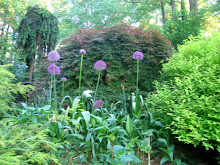
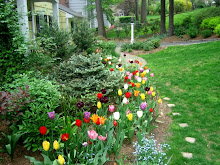
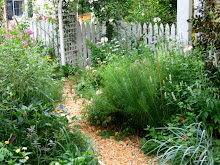
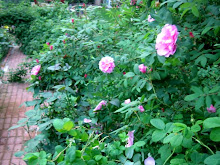

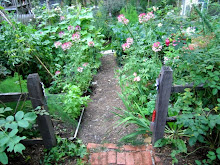

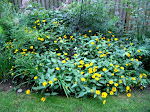





5 comments:
Your roses are very pretty! I would like to try a few if I would not have to use chemicals.
I have already had some photos ready of a couple kinds of plants in my beds throughout the season that I have planned to find time to put in my blog. I'll have to check out the meme and decide whether to join it, or just do my own thing.
Old roses rock! I have used them for many years in North FL, and have found them relatively disease free, hardy in the (relatively mild) winters there, and very easy to take care of. I never sprayed. If they died of disease, I tried another variety. Good varieties for Northern FL: Valentine (bush), Hypolyta (bush, blooms once a year), Lemarque (climber), Mermaid (very aggressive climber), and many more. Hint about Mermaid: only plant next to your fence when you want no one, and I mean NO ONE, to climb it! Even my fence-loving cats didn't climb where the Mermaid grew. Prune often. Great old rose supplier that I have used many times: The Antique Rose Emporium at http://www.antiqueroseemporium.com/.
How wonderful! I've been blogging about landscape design in Chatham for the past year after I dropped out of a forum I had participated in for 10 years. Mine is very different from yours and Marta McDowell's. It's interesting that all three of us live within a mile of each other, love gardens and gardening and have the need to share it! Bravo.
Susan,
I'll have to check out your blog. Thank you for visiting.
-Heirloom Gardener
I have got this one in my country side garden at my 'summerhouse' and yes it is wonderful ptetty and this lovely strong scent....mmm lovely. I wish a could smell your beautiful pictures!/ Tyra
TYRA'S GARDEN
Post a Comment